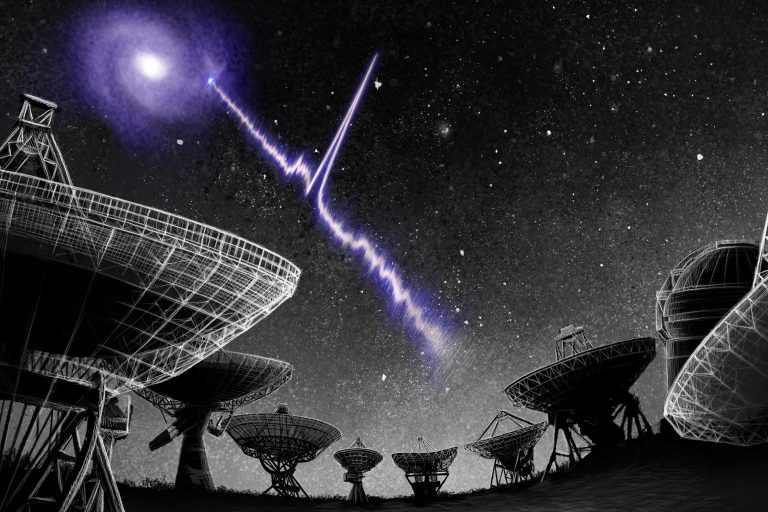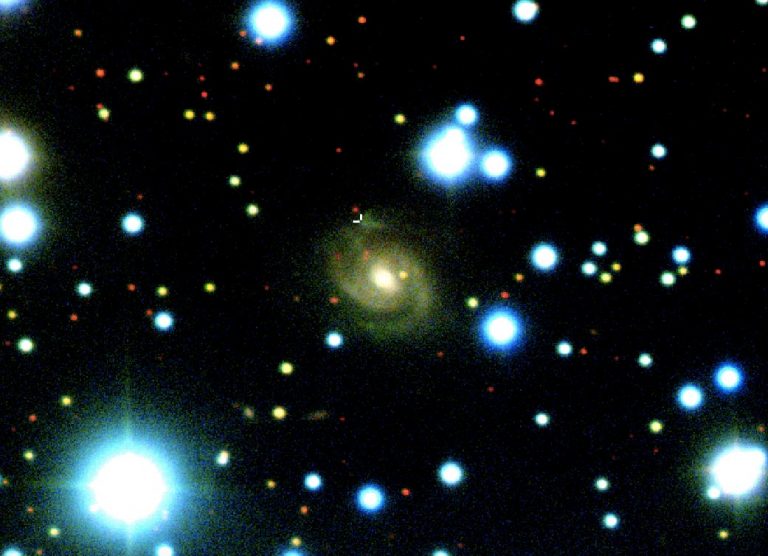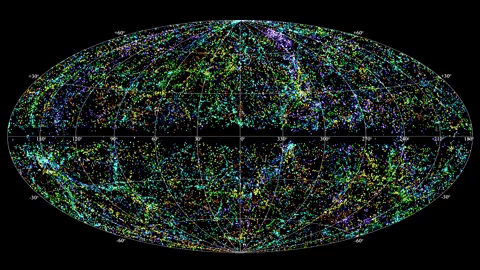Welcome to DU!
The truly grassroots left-of-center political community where regular people, not algorithms, drive the discussions and set the standards.
Join the community:
Create a free account
Support DU (and get rid of ads!):
Become a Star Member
Latest Breaking News
General Discussion
The DU Lounge
All Forums
Issue Forums
Culture Forums
Alliance Forums
Region Forums
Support Forums
Help & Search
Science
Related: About this forumAstronomers Stunned by Repeating Fast Radio Burst Detected in Nearby Galaxy
TOPICS:AstronomyAstrophysics West Virginia University
By WEST VIRGINIA UNIVERSITY JANUARY 6, 2020

An artist’s conception of the localization of Fast Radio Burst 180916.J0158+65 to its host galaxy. The host galaxy image is based on real observations using the Gemini-North telescope atop Mauna Kea in Hawaii. The impulsive burst emanating from the galaxy is based on real data recorded using the 100-metre Effelsberg radio telescope in Germany. Credit: Danielle Futselaar, artsource.nl
For more than a decade, astronomers across the globe have wrestled with the perplexities of fast radio bursts — intense, unexplained cosmic flashes of energy, light years away, that pop for mere milliseconds.
Despite the hundreds of records of these enigmatic sources, researchers have only pinpointed the precise location of four such bursts.
Now there’s a fifth, detected by a team of international scientists that includes West Virginia University researchers. The finding, which relied on eight telescopes spanning locations from the United Kingdom to China, was published today (Monday, January 6, 2020) in Nature.

Image of SDSS J015800.28+654253.0, the host galaxy of Fast Radio Burst 180916.J0158+65 – acquired with the Gemini-North telescope. The position of the FRB in the spiral arm of the galaxy is marked by white cross hairs. Credit: Shriharsh Tendulkar/Gemini Observatory
There are two primary types of fast radio bursts, explained Kshitij Aggarwal, a physics graduate student at WVU and a co-author of the paper: repeaters, which flash multiple times, and non-repeaters, one-off events. This observation marks only the second time scientists have determined the location of a repeating fast radio burst.
More:
https://scitechdaily.com/astronomers-stunned-by-repeating-fast-radio-burst-detected-in-nearby-galaxy/
InfoView thread info, including edit history
TrashPut this thread in your Trash Can (My DU » Trash Can)
BookmarkAdd this thread to your Bookmarks (My DU » Bookmarks)
5 replies, 1483 views
ShareGet links to this post and/or share on social media
AlertAlert this post for a rule violation
PowersThere are no powers you can use on this post
EditCannot edit other people's posts
ReplyReply to this post
EditCannot edit other people's posts
Rec (13)
ReplyReply to this post
5 replies
 = new reply since forum marked as read
Highlight:
NoneDon't highlight anything
5 newestHighlight 5 most recent replies
= new reply since forum marked as read
Highlight:
NoneDon't highlight anything
5 newestHighlight 5 most recent replies
Astronomers Stunned by Repeating Fast Radio Burst Detected in Nearby Galaxy (Original Post)
Judi Lynn
Jan 2020
OP
ZZenith
(4,124 posts)1. Hmmm... it appears to be some kind of code...
“ ..-. ..- -.-. -.- - .-. ..- -- .--. -·-·--”
What could it mean? ![]()
SeattleVet
(5,477 posts)2. Definitely a sign of intelligent life!
We should send them some good news back:
-... -.-- - .... . - .. -- . -.-- --- ..- .-. . .- -.. - .... .. ... --··-- .... . .-- .. .-.. .-.. -... . .-.. --- -. --. -.. . .- -.. -·-·--
ZZenith
(4,124 posts)3. You know they're gonna wanna come see for themselves, though.
Just to make sure.
![]()
DFW
(54,414 posts)4. They should take care not to be too disappointed
Who would want to admit that all this effort was spent just to find that home-owners insurance on some planet near Alpha Centauri was on sale 271 million light years ago?
Judi Lynn
(160,555 posts)5. Origin of Deep-Space Radio Flash Discovered, and It's Unlike Anything Astronomers Have Ever Seen
By Adam Mann - Live Science Contributor 11 hours ago
Things are only getting more confusing.

An animation shows the random appearance of fast radio bursts (FRBs) across the sky.
(Image: © NRAO Outreach/T. Jarrett (IPAC/Caltech); B. Saxton, NRAO/AUI/NSF)
HONOLULU — Mysterious ultra-fast pinpricks of radio energy keep lighting up the night sky and nobody knows why. A newly discovered example of this transient phenomenon has been traced to its place of origin — a nearby spiral galaxy — but it's only made things murkier for astronomers.
The problem concerns a class of blink-and-you'll-miss-them heavenly events known as fast radio bursts (FRBs). In a few thousandths of a second, these explosions produce as much energy as the sun does in nearly a century. Researchers have only known about FRBs since 2007, and they still don't have a compelling explanation regarding their sources.
"The big question is what can produce an FRB," Kenzie Nimmo, a doctoral student at the University of Amsterdam in the Netherlands, said during a news briefing on Monday (Jan. 6) here at the 235th meeting of the American Astronomical Society in Honolulu, Hawaii.
Scientists were given some help in 2016, when they discovered an FRB that repeated its quick-pulsing radio tune in random bursts. All previous examples had been one-off events.
More:
https://www.livescience.com/fast-radio-bursts-traced-to-origin.html